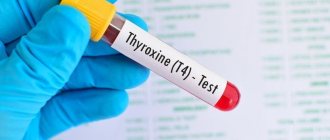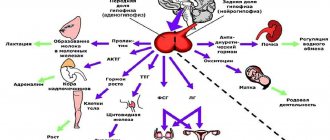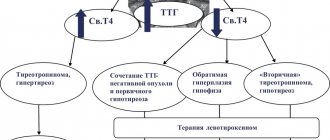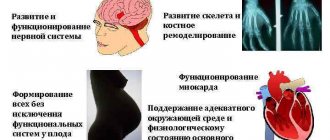Thyrotoxicosis
Vomit
Jaundice
34253 08 February
IMPORTANT!
The information in this section cannot be used for self-diagnosis and self-treatment. In case of pain or other exacerbation of the disease, diagnostic tests should be prescribed only by the attending physician. To make a diagnosis and properly prescribe treatment, you should contact your doctor. Definition
Thyrotoxicosis is a clinical syndrome that occurs when there is an increased level of thyroid hormones in the blood. An excess of these hormones affects the functioning of various organs and systems. Patients complain of dry skin, brittle hair, puffiness of the face, and may experience slight tremor of the eyelids, fingers, and even the whole body. There are slight temperature fluctuations, increased nervous excitability, sweating, a feeling of heat, and fussiness. There are sudden attacks of muscle weakness. A person becomes quarrelsome, suspicious, and overly active. Sleep is disturbed.
The patient experiences swelling and darkening of the skin of the upper eyelids, lacrimation, photophobia, a feeling of pressure and “sand” in the eyes, and bulging eyes (exophthalmos). With moderate or severe eye damage, a decrease in visual acuity may be observed; patients cannot close their eyelids, so damage to the cornea and sclera develops (ulceration, infection).
In some patients, lesions of the skin and subcutaneous fatty tissue develop on the anterior surface of the leg - clearly defined compactions of a purplish-bluish color (erythema nodosum). In men, thickening of the phalanges of the fingers is sometimes observed due to tissue swelling.
Due to the influence of thyroid hormones on the cardiovascular system, patients are concerned about heart rhythm disturbances (tachycardia, extrasystole, atrial fibrillation).
Gastrointestinal disorders are common. Even with increased appetite, body weight decreases due to accelerated metabolism. There may be attacks of abdominal pain, vomiting, upset stool, and sometimes constipation. In severe cases, the liver is affected - its enlargement, pain, and rarely jaundice are recorded.
Under the influence of provoking factors (stressful situations, physical overexertion, infectious diseases, surgery), a thyrotoxic crisis may occur. As a result of the sudden release of a large amount of thyroid hormones into the blood, patients become restless, body temperature rises significantly, tachycardia sharply increases, breathing becomes more frequent, and blood pressure rises.
Types of thyrotoxicosis
I. Thyrotoxicosis caused by increased production of thyroid hormones:
- Graves' disease (diffuse toxic goiter).
- Multinodular toxic goiter.
- Toxic adenoma of the thyroid gland.
- Thyroid cancer.
- TSH-secreting pituitary adenoma.
II. Thyrotoxicosis caused by the production of thyroid hormones outside the thyroid gland:
- Chorionepithelioma.
- Struma ovarii (ovarian tumor).
- Functioning metastases of thyroid cancer.
III. Thyrotoxicosis not associated with overproduction of thyroid hormones:
- Drug-induced thyrotoxicosis.
- Thyrotoxic phase of destructive thyroiditis (subacute, postpartum).
Based on the severity of the course, mild, moderate and severe forms of thyrotoxicosis are distinguished.
In a mild form of thyrotoxicosis, the pulse does not exceed 100 beats per minute, the loss of body weight is no more than 5 kg, and there are no or mild ocular symptoms. In the moderate form - pulse 100-120 beats per minute, weight loss - 8-10 kg, pronounced tremor (shaking), increased systolic blood pressure and decreased diastolic pressure, exophthalmos. A severe form develops with long-term thyrotoxicosis without treatment. The pulse rate is 120-140 beats per minute, weight loss reaches exhaustion, damage to the cardiovascular system, liver, and adrenal glands is observed.
Possible causes of thyrotoxicosis
An increase in thyroid hormones in the blood can be observed for several reasons:
- as a result of increased production of thyroid hormones in the thyroid gland;
- as a result of the destruction of thyroid tissue and the release of large amounts of thyroid hormones into the blood;
- in case of an overdose of thyroid hormone drugs or as a result of side effects of drug therapy with amiodarone.
Diffuse toxic goiter (Graves disease) is the most common cause of increased production of thyroid hormones.
Depending on the nature of the enlargement of the thyroid gland, a distinction is made between diffuse toxic goiter (diffuse enlargement of all parts of the gland) and nodular toxic goiter (focal enlargement of the thyroid gland). If the node producing hormones in increased quantities is single, then they speak of a toxic adenoma.
Diffuse toxic goiter is an autoimmune disease in which antibodies appear to the structural components of the cells of the own thyroid gland. Antibodies are special immunoglobulin proteins (Ig) that are produced by the immune system in response to the entry of any foreign agent into the body to combat it. In this case, the immune system recognizes the thyroid tissue as foreign.
These antibodies have a stimulating effect on the thyroid gland, causing its hyperfunction with an increase in the volume, weight of the gland, and, consequently, the concentration of thyroid hormones in the blood. Antibodies are able to cross the placental barrier and cause thyrotoxicosis in newborns. Therefore, identifying antibodies in pregnant women is of great importance for the unborn child.
Thyrotoxicosis can be observed against the background of subacute thyroiditis. Subacute thyroiditis (inflammation of the thyroid tissue) occurs as a result of a viral disease and proceeds as a typical inflammation. In the period preceding the development of the disease, muscle pain, malaise, low-grade fever, general weakness, sore throat, and fatigue may be observed. Then comes moderate to severe pain in the thyroid area, often radiating to the ears, jaw or throat. Sometimes there is pain when swallowing and turning the head. The thyroid gland is usually slightly enlarged; increasing fibrosis of the gland (proliferation of connective tissue) is manifested by an increase in its density.
There are 4 phases in the development of subacute thyroiditis. The first is thyrotoxic, which lasts from 4 to 10 weeks. It develops in the acute stage of the disease due to increased vascular permeability against the background of inflammation and increased release of previously synthesized thyroid hormones. Patients exhibit symptoms of thyrotoxicosis. When the thyroid hormone reserves are depleted, the euthyroid phase begins, which lasts 1–3 weeks. It is replaced by a hypothyroid phase, lasting from 2 to 6 months, and then recovery occurs.
The phenomena of thyrotoxicosis can manifest against the background of postpartum thyroiditis 1.5-3 months after birth.
Chorionepithelioma is a malignant neoplasm that is formed from chorionic epithelial cells during or after pregnancy, most often in the uterus and produces the hormone chorionic gonadotropin. This hormone is a weak stimulator of thyroid cells. But at high concentrations (300,000 units/l), thyrotoxicosis can occur.
Struma ovarii, or ovarian tumor, refers to teratomas (tumors from atypical tissue for a given location), in which thyroid tissue predominates or constitutes a significant component of the tumor. In 20-30% of cases, the tumor is represented only by thyroid tissue. 5-6% of these tumors produce thyroid hormones in quantities sufficient to develop thyrotoxicosis.
Large hormonally active metastases of follicular thyroid cancer are very rare causes of thyrotoxicosis.
Thyrotoxicosis can occur with an overdose of thyroid hormones, due to inadequate iodine prophylaxis or during the use of amiodarone.
Amiodarone is a highly effective and widely used antiarrhythmic drug in cardiology. Thyroid dysfunction is a common side effect of amiodarone, caused either by excessive uncontrolled synthesis of hormones in response to iodine load and/or destruction of the gland. Amiodarone-induced thyrotoxicosis is of great importance because it aggravates the course of cardiovascular disease.
Which doctors should I contact for thyrotoxicosis?
At the first manifestations of thyrotoxicosis, you should consult a physician or general practitioner. When the diagnosis is confirmed after a set of laboratory and diagnostic measures, the endocrinologist prescribes therapy, carries out its correction and monitors the course of the disease.
Diagnosis and examinations for thyrotoxicosis
In diagnosing the disease, in addition to a detailed interview and examination of the patient, during which signs of thyrotoxicosis are identified, data from laboratory and instrumental research methods are used.
- Clinical blood test with determination of hemoglobin concentration, number of erythrocytes, leukocytes and platelets, hematocrit and erythrocyte indices (MCV, RDW, MCH, MCHC), leukoformula and ESR (with microscopy of a blood smear in the presence of pathological changes).
Treatment
Specialists from the endocrinology department of the CELT clinic have been successfully treating thyrotoxicosis for several years now.
Based on the examination and diagnostic data obtained, three treatment options are possible:
- conservative treatment, which consists of taking medications that reduce the activity of the thyroid gland;
- surgery involving complete or partial removal of the thyroid gland;
- treatment with radioactive iodine.
Conservative treatment
most often chosen for patients with thyrotoxicosis against the background of diffuse toxic goiter or autoimmune thyroiditis. Treatment, usually long-term, includes taking drugs that block the function of the thyroid gland and the metabolism of hormones in the body (thyreostatics). Treatment is carried out under careful monitoring of general condition, thyroid status (monitoring free T4 every 2 weeks), clinical blood test and biochemical parameters. This is necessary in order to prevent the development of hypothyroidism (low levels of thyroid hormones) and cytotoxic side effects from the drugs. Subsequently, monitoring is carried out somewhat less frequently, once every 2 months, in order to assess the adequacy of the drug dose and maintain persistent euthyroidism (normal levels of thyroid hormones).
Additional medications for the treatment of thyrotoxicosis include beta blockers and prednisolone. They are prescribed in cases of severe thyrotoxicosis and prolonged decompensation.
In case of thyrotoxicosis, therapy with iodine preparations is contraindicated (with the exception of pregnancy, when iodine is necessary for the formation of a normal thyroid gland in the fetus)!
Interpretation of thyroid tests
| TSH | T3 | T4 | Presumable diagnosis |
| Short | High | Normal |
|
| Short | Normal | High |
|
| Normal or high | High | High |
|
Tags:
TSH, thyroid gland, hyperthyroidism, thyrotoxicosis, thyroiditis, pituitary tumors, Graves' disease
Back to section
Examination and physical examination
When examining and auscultating a patient with hyperthyroidism, you can find:
- skin is usually moist and hot to the touch;
- tachycardia;
- possible arrhythmia (irregular pulse);
- possible systolic hypertension (increased systolic pressure);
- tremor (shaking) of the limbs;
- increased reflexes;
- weakness of the muscles of the limbs;
- exophthalmos, periorbital edema, limited mobility of the eyeball - symptoms of Graves' disease - an autoimmune disease of the thyroid gland with hyperthyroidism.
Complications of hyperthyroidism
As the disease progresses, the symptoms of thyroid hyperthyroidism intensify, and complications may arise:
- Disturbances in the functioning of the heart . Atrial fibrillation is added to the general symptoms of hyperthyroidism. The patient does not tolerate physical activity well, and there is a disturbance in heart rhythm. Congestive heart failure may develop. The consequences are reversible. After eliminating hyperthyroidism, the signs of arrhythmia are completely cured.
- Increased bone fragility . In its advanced form, hyperthyroidism causes disturbances in the structure of bone tissue. Osteoporosis develops. The reason bones become brittle is that excess hormones prevent calcium from being incorporated into the bone.
- Eye diseases . Graves' ophthalmopathy adds to the symptoms of hyperthyroidism. The cause of the pathology is the growth and swelling of the tissues located behind the eyeballs. The patient feels pain in the eyes, sensitivity to light, and complains of double vision. Visual acuity gradually decreases. In advanced cases, blindness develops.
- Skin problems . Ocular symptoms in hyperthyroidism often develop in parallel with Graves' dermopathy. The skin becomes swollen and red, especially around the feet and legs.
- Thyrotoxic crisis . An increase in the level of thyroid hormones in the blood can cause a sudden fever and an increase in all the main symptoms. Thyrotoxic crisis is accompanied by tachycardia. In some cases, delirium (mental disorder) occurs. The patient requires emergency medical care.
Diagnostics
Treatment of patients with pathology of the endocrine system begins with a visit to a therapist or directly to an endocrinologist. The doctor, after a detailed questioning about the symptoms and possible causes of the painful condition, conducts an examination, including palpation of the thyroid area.
If, as a result of the initial diagnosis, a primary diagnosis of “thyrotoxicosis” is established, the patient is referred for a more informative comprehensive examination:
- laboratory methods - blood tests (for hormones, antibodies, sugar levels, general indicators, etc.);
- ultrasound examination to determine the condition of the gland, mainly to determine its size and the possible presence of formations;
- scintigraphy - the use of radioactive isotopes to visualize an organ in a two-dimensional image;
- aspiration biopsy - collection of gland cells for research;
- computed tomography/magnetic resonance imaging - if pituitary dysfunction is suspected.
Additionally, diagnostics can be carried out on other organs, since the disease is accompanied by multiple complications.
Enlarged thyroid gland. Palpation of the thyroid gland
The presence or absence of a goiter depends on the condition that caused hyperthyroidism:
- enlargement of the thyroid gland from slight to giant is observed in patients with Graves' disease or toxic multinodular goiter, while in elderly patients with Graves' disease the thyroid gland may not be palpable;
- patients with painless thyroiditis may have a non-enlarged or slightly enlarged thyroid gland;
- a single node may suggest a thyroid adenoma;
- The thyroid gland is sensitive and painful in subacute thyroiditis.
Causes
Thyrotoxicosis is a consequence disease, since the pathology occurs against the background of another thyroid disease. The main provoking factors include: diffuse goiter (toxic) and Basedow's disease.
Typical reasons are also considered:
- hereditary predisposition according to genetic type;
- autoimmune diseases.
Specialists observing patients with thyrotoxicosis note the negative impact on the endocrinological system of the following factors:
- constantly being in a state of stress;
- nodular form of toxic goiter;
- exceeding the consumed daily dose of iodine;
- infectious processes affecting the epithelial cells of the thyroid gland;
- taking hormonal drugs in large doses.
These reasons do not always lead to thyrotoxicosis. Hormonal imbalance occurs with prolonged or complete absence of therapeutic measures to eliminate the underlying pathologies.
Types of hyperthyroidism
There are three forms of the disease:
- Subclinical. There are no obvious symptoms, T4 levels are normal, triiodothyronine levels are low;
- Manifest. Characteristic signs of hyperthyroidism appear. T4 level is normal, triiodothyronine level is low;
- Complicated. Symptoms include heart failure, arrhythmia, psychosis and other severe conditions.
According to the level of occurrence of hyperthyroidism, there are:
- primary – pathology of the thyroid gland;
- secondary – the pituitary gland is affected;
- tertiary – processes develop in the hypothalamus.
Read also
Metabolic syndrome
Metabolic syndrome is a “pandemic of the 21st century.”
The prevalence of metabolic syndrome is 20–40%. In the Russian Federation, 40% of the population have 2 components of metabolic syndrome, 11% –… Read more
Hyperparathyroidism
Physiology of the parathyroid glands The parathyroid glands produce parathyroid hormone, the main hormone that regulates the metabolism of calcium and vitamin D (under the influence of parathyroid hormone, vitamin D becomes active)…
More details
Symptomatic arterial hypertension
Arterial hypertension is a very common disease of the human cardiovascular system. According to statistics, 20-30% of the population suffers from arterial hypertension, aged 60 years and above...
More details
Complications of diabetes
Diabetes mellitus (DM) is a systemic disease caused by absolute (type 1) insulin deficiency or insulin resistance (type 2), which causes impaired carbohydrate metabolism, manifested by chronic...
More details
Hyperprolactinemia
Hyperprolactinemia is a persistent increase in the level of the hormone prolactin in the blood. Hyperprolactinemia syndrome is a complex of symptoms that occur against the background of increased prolactin levels, the most characteristic...
More details





